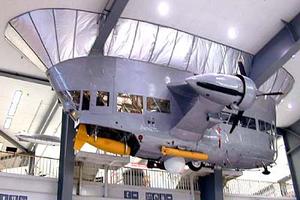BlimpsU.A. Navy sees blimp come-back
In 1962, after forty-seven years, the U.S. Navy effectively terminated Lighter-Than-Air (LTA) operations; but the blimp is making a come-back, and on 26 October, the Naval Air Warfare Center Aircraft Division and the U.S. Naval Research Laboratory unveiled the MZ-3A airship; for now, it is the only manned airship in the U.S. Navy’s inventory

Gondola of the U.S. Navy airship K-47 // Source: airventure.de
On 26 October, at a ceremonious ribbon-cutting event at the Naval Air Warfare Center Aircraft Division (NAWCAD) in Lakehurst, New Jersey, NAWCAD and the U.S. Naval Research Laboratory, unveiled the MZ-3A airship, which now carries the insignia of Scientific Development Squadron ONE (VXS-1) and the banner of the U.S. Navy.
“It’s been nearly 50 years since the last U.S. Navy Lighter-Than-Air platform cruised the skies over the New Jersey coastline,” said CDR Jay Steingold, Commanding Officer, VXS-1. “Today, the MZ-3A joins the ranks of her predecessors by sporting the emblems of the United States Navy, marking an important milestone in the history of naval airships.”
A Navy Research Lab release reports that after forty-even years, the U.S. Navy effectively terminated Lighter-Than-Air (LTA) operations on 31 August 31 1962, with the final flight of a ZPG-2 airship at Naval Air Station Lakehurst.
The MZ-3A, with red, white, and blue stripes painted on its rudders in acknowledgement of the Navy’s Centennial of Flight and earliest days of Navy airship operations, now serves as the only manned airship in the U.S. Navy’s inventory.
Built by Hillsboro, Oregon-based American Blimp Corporation, the MZ-3A is propeller-driven by two 180 horsepower Lycoming engines producing a top speed just under 50 knots with an operational payload capability of up to 2,500 pounds.
The manned 178-foot LTA craft can remain aloft and nearly stationary for more than twelve hours, performing various missions in support of technology development for Command, Control, Communications, Computers, Intelligence, Surveillance and Reconnaissance (C4ISR) concepts.
“Airships offer extreme utility in C4ISR roles and patrol missions where persistent stare and reliable communications are often more important than speed,” said Bert Race, MZ-3A Government Flight Representative and Project Manager. “Our MZ-3A has proven that an airship is a very effective platform for mission system research and development.”
The MZ-3A is government-owned and contractor-operated. The contractor, Integrated Systems Solutions, Inc., employs commercial blimp pilots whom the Navy has approved to command the airship.
Scientific Development Squadron ONE (VXS-1), stationed at the Naval Air Station, Patuxent River, Maryland, is the U.S. Navy’s sole Science & Technology research squadron. Commissioned in December 2004, VXS-1 employs NP-3D Orions, RC-12 Guardrails, Scan Eagle UAS, and most recently, the MZ-3A in its support of NRL airborne research efforts.
The release notes that since its transfer to VXS-1 in 2009, the MZ-3A has accumulated more than 1,000 mishap-free flight hours in support of the Naval Research Enterprise and recently provided assistance during the Gulf of Mexico Oil Spill in 2010.
